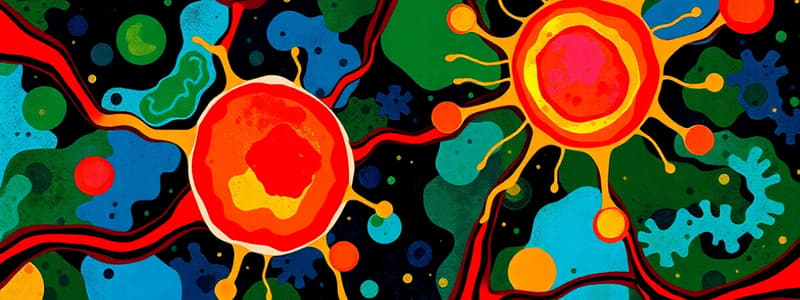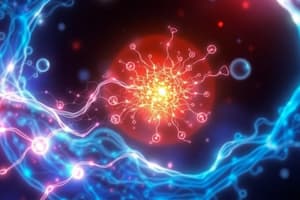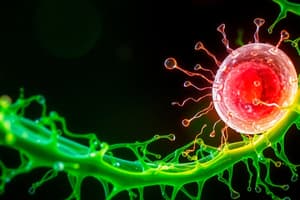Podcast
Questions and Answers
What is the role of G proteins in relation to G protein-coupled receptors?
What is the role of G proteins in relation to G protein-coupled receptors?
- They enhance mRNA translation.
- They serve as an on/off switch. (correct)
- They transport proteins across the membrane.
- They initiate apoptosis in cells.
Which of the following is NOT a type of plasma membrane receptor mentioned?
Which of the following is NOT a type of plasma membrane receptor mentioned?
- Transcription factors (correct)
- Ion channels
- Tyrosine kinases
- G-protein-coupled
What can interfere with G protein function and potentially lead to disease?
What can interfere with G protein function and potentially lead to disease?
- Toxins such as cholera and botulinum (correct)
- Viral proteins
- Excess calcium ions
- Cholesterol buildup
Which statement accurately reflects the role of G proteins in medicine?
Which statement accurately reflects the role of G proteins in medicine?
When the G protein is bound to GDP, what is its state?
When the G protein is bound to GDP, what is its state?
What type of junction is primarily responsible for anchoring actin microfilaments to the basal lamina?
What type of junction is primarily responsible for anchoring actin microfilaments to the basal lamina?
Which proteins are primarily associated with tight junctions?
Which proteins are primarily associated with tight junctions?
What junction type facilitates cell-to-extracellular matrix (ECM) interactions?
What junction type facilitates cell-to-extracellular matrix (ECM) interactions?
Which junction type is characterized by its role in connecting cytoskeletal elements to neighboring cells?
Which junction type is characterized by its role in connecting cytoskeletal elements to neighboring cells?
What is the primary function of anchoring junctions?
What is the primary function of anchoring junctions?
What role do second messengers play in cellular processes?
What role do second messengers play in cellular processes?
Which of the following is an example of a second messenger?
Which of the following is an example of a second messenger?
How is cyclic AMP (cAMP) produced?
How is cyclic AMP (cAMP) produced?
Which enzyme is responsible for the breakdown of cyclic AMP (cAMP)?
Which enzyme is responsible for the breakdown of cyclic AMP (cAMP)?
What is the source of the phosphate group in cyclic AMP synthesis?
What is the source of the phosphate group in cyclic AMP synthesis?
Cyclic AMP (cAMP) can be classified as which type of biological molecule?
Cyclic AMP (cAMP) can be classified as which type of biological molecule?
Which statement about second messengers is true?
Which statement about second messengers is true?
Which of the following best describes the nature of second messengers?
Which of the following best describes the nature of second messengers?
What is an example of long-distance signaling in multicellular organisms?
What is an example of long-distance signaling in multicellular organisms?
What distinguishes local signaling from long-distance signaling?
What distinguishes local signaling from long-distance signaling?
Which type of receptor is primarily involved in recognizing local regulators in animal cells?
Which type of receptor is primarily involved in recognizing local regulators in animal cells?
What is the primary function of paracrine signaling?
What is the primary function of paracrine signaling?
What role do second messengers play in cell signaling?
What role do second messengers play in cell signaling?
Which type of signaling uses neurotransmitters released from nerve cells?
Which type of signaling uses neurotransmitters released from nerve cells?
Which of the following describes cell-to-cell recognition?
Which of the following describes cell-to-cell recognition?
What do gap junctions in animal cells lack?
What do gap junctions in animal cells lack?
What is the primary function of intercellular communication in multicellular organisms?
What is the primary function of intercellular communication in multicellular organisms?
Which junction type connects cells using actin microfilaments?
Which junction type connects cells using actin microfilaments?
What does the term 'paracrine signaling' refer to?
What does the term 'paracrine signaling' refer to?
Which of the following is a feature of synaptic signaling?
Which of the following is a feature of synaptic signaling?
Which type of signaling mechanism involves cell junctions?
Which type of signaling mechanism involves cell junctions?
What is a key characteristic of desmosomes?
What is a key characteristic of desmosomes?
In which type of signaling do secretory vesicles play a crucial role?
In which type of signaling do secretory vesicles play a crucial role?
What is the main role of local regulators in cellular communication?
What is the main role of local regulators in cellular communication?
What occurs during the reception stage of cell signaling?
What occurs during the reception stage of cell signaling?
Which type of receptors bind to signaling molecules that can readily cross the plasma membrane?
Which type of receptors bind to signaling molecules that can readily cross the plasma membrane?
What is a common example of a signaling molecule that binds to intracellular receptors?
What is a common example of a signaling molecule that binds to intracellular receptors?
What is the role of tamoxifen in the treatment of ER+ breast cancer?
What is the role of tamoxifen in the treatment of ER+ breast cancer?
What type of change does a receptor protein undergo upon binding of a signaling molecule?
What type of change does a receptor protein undergo upon binding of a signaling molecule?
What characteristic best describes the binding between a signaling molecule and its receptor?
What characteristic best describes the binding between a signaling molecule and its receptor?
Which of these is an intracellular receptor example?
Which of these is an intracellular receptor example?
What triggers the activation of a cellular response during cell signaling?
What triggers the activation of a cellular response during cell signaling?
Flashcards
Intercellular communication
Intercellular communication
Cells communicate within a multicellular organism.
Universal mechanisms of cellular regulation
Universal mechanisms of cellular regulation
Mechanisms that regulate cellular function across different species.
Signal transduction pathways
Signal transduction pathways
Conversion of signals from outside the cell into responses within the cell.
Local signaling
Local signaling
Signup and view all the flashcards
Long distance signaling
Long distance signaling
Signup and view all the flashcards
Direct contact signaling
Direct contact signaling
Signup and view all the flashcards
Cell-cell recognition
Cell-cell recognition
Signup and view all the flashcards
Local regulators
Local regulators
Signup and view all the flashcards
Paracrine signaling
Paracrine signaling
Signup and view all the flashcards
Synaptic signaling
Synaptic signaling
Signup and view all the flashcards
Gap junctions
Gap junctions
Signup and view all the flashcards
Plasmodesmata
Plasmodesmata
Signup and view all the flashcards
Tight junctions
Tight junctions
Signup and view all the flashcards
Desmosomes
Desmosomes
Signup and view all the flashcards
Adherens junctions
Adherens junctions
Signup and view all the flashcards
Anchoring junctions
Anchoring junctions
Signup and view all the flashcards
Cell-cell junctions
Cell-cell junctions
Signup and view all the flashcards
Cell-ECM junctions
Cell-ECM junctions
Signup and view all the flashcards
Focal adhesions
Focal adhesions
Signup and view all the flashcards
Plasma Membrane Receptors
Plasma Membrane Receptors
Signup and view all the flashcards
G Protein-Coupled Receptors
G Protein-Coupled Receptors
Signup and view all the flashcards
Tyrosine Kinases
Tyrosine Kinases
Signup and view all the flashcards
Ion Channels
Ion Channels
Signup and view all the flashcards
G Proteins
G Proteins
Signup and view all the flashcards
Reception in cell signaling
Reception in cell signaling
Signup and view all the flashcards
Conformational change in cell signaling
Conformational change in cell signaling
Signup and view all the flashcards
Intracellular receptors
Intracellular receptors
Signup and view all the flashcards
Steroid hormones
Steroid hormones
Signup and view all the flashcards
Steroid hormone receptors
Steroid hormone receptors
Signup and view all the flashcards
Tamoxifen
Tamoxifen
Signup and view all the flashcards
Estrogen antagonist
Estrogen antagonist
Signup and view all the flashcards
Second Messengers
Second Messengers
Signup and view all the flashcards
Cyclic AMP (cAMP)
Cyclic AMP (cAMP)
Signup and view all the flashcards
Adenylyl Cyclase
Adenylyl Cyclase
Signup and view all the flashcards
Phosphodiesterase
Phosphodiesterase
Signup and view all the flashcards
Calcium Ions (Ca+2)
Calcium Ions (Ca+2)
Signup and view all the flashcards
Signal Transduction
Signal Transduction
Signup and view all the flashcards
Signal Amplification
Signal Amplification
Signup and view all the flashcards
Study Notes
Cell Communication Overview
- Intercellular communication (cell-to-cell) is crucial for multicellular organisms.
- Scientists have found universal cellular regulation mechanisms in diverse organisms (microbes and mammals).
- This suggests a shared evolutionary ancestry.
- Examples show multiple molecules controlling complex functions like blood vessel dilation.
Learning Objectives
- Understand the mechanisms of cell-to-cell communication, differentiating between local and long-distance signaling.
- Describe the stages of a cell signaling process.
- Identify and explain the function of various intracellular and plasma membrane receptors.
- Outline the role of second messengers in signal transduction cascades.
- Distinguish intercellular junctions in animal and plant cells and their functions.
Local Signaling
- Direct contact: Cells communicate through cell junctions (animal and plant cells) or recognizing each other via surface molecules (animal cells).
- Local regulators: In paracrine signaling, messenger molecules travel short distances to target cells (e.g., growth factors). Synaptic signaling uses neurotransmitters released at synapses between nerve cells.
Cell Junctions
- Gap junctions (animal cells), plasmodesmata (plant cells): Channels that connect adjacent cell cytoplasms, coordinating tissue function.
Cell-Cell Recognition
- Animal cells often communicate through direct contact using surface molecules (e.g., membrane carbohydrates).
Communication by Local Regulators
- Paracrine and synaptic signaling enable animals to communicate using local regulators (e.g., growth factors, neurotransmitters). These travel only short distances.
Types of Intercellular Junctions in Animals
- Tight junctions: Prevent intercellular communication and often block material exchange in cells that need to act as a barrier.
- Desmosomes: Anchor cells through the extracellular matrix.
- Gap junctions: Channels between cells permitting molecule exchange.
Gap Junctions
- Cytoplasmic channels (connexins) connect adjacent cells.
- Essential for cell-to-cell communication.
- Allow the exchange of small molecules and ions (e.g., cAMP, Ca+2).
- Found in various tissues (e.g., epithelial cells, heart muscle).
- Essential for the coordinated contraction of certain tissues like intestines and uterus during childbirth.
Tight Junctions
- Located beneath the apical surface of epithelial cells.
- Prevent cell-to-cell communication in cases where material exchange is unwanted or needs to be controlled.
- Create a watertight seal preventing the leakage of extracellular fluid.
- Formed by claudin and occludin transmembrane proteins.
- Occludin's cytoplasmic part connects to actin microfilaments.
Anchoring Junctions
- Connect neighboring cells (cell-to-cell) and cells to the ECM (cell-to-ECM connections).
- Desmosomes: Function like rivets fastening cells together into strong sheets, anchoring cells through intermediate filaments (e.g., keratin).
- Adherens junctions: Create an adhesion zone around the epithelial cells. Connect plasma membranes via transmembrane adhesion proteins (cadherins). These connect intracellularly with actin microfilaments with the help of catenins, vinculin, and a-actinin.
Focal Adhesions (Cell-ECM connection)
- Connect cells to the extracellular matrix (ECM) through integrins.
- Integrin cytoplasmic domain connects with actin microfilaments through proteins like talin, α-actinin, and vinculin.
Hemidesmosomes (Cell-ECM connection)
- Found at the basal surface of epithelial cells.
- Stabilize cells to the extracellular matrix (ECM) through integrins binding to ECM proteins like laminin.
- Intracellularly connect with keratin intermediate filaments through plectin.
Long-Distance Signaling
- Both plants and animals use hormones for long-distance communication.
- Hormonal signaling (endocrine signaling) is how cells specialize to release hormones (chemical messengers) into body fluids. The circulatory system conveys hormones to target cells (often in other parts of the body) which act in response.
Stages of Cell Signaling
-
- Reception: A signaling molecule (ligand) binds to a receptor protein.
-
- Transduction: The receptor protein's change in shape initiates a cascade of molecular changes.
-
- Response: The transduced signal triggers a specific cellular response (e.g., change in enzyme activity, gene expression).
Receptor Types
- Intracellular receptors: Located inside the cell. Small or hydrophobic signaling molecules (like steroid hormones) can easily pass through the cell membrane.
- Plasma membrane receptors: Located on the cell surface. Large or hydrophilic signaling molecules cannot directly enter the cell, so they interact with the receptor at the cell's outer surface. They are further divided into distinct types, including:
- G-protein-coupled receptors
- Tyrosine kinases
- Ion channels
Second Messengers
- Small, non-protein, water-soluble molecules or ions (e.g., cAMP, Ca+2, DAG, IP3) that relay signals in transduction pathways.
- cAMP is produced from ATP through adenylyl cyclase.
- Calcium ions (Ca2+) act as second messengers, regulating diverse cellular responses.
Transduction Pathways
- Signal transduction pathways utilize cascades of molecular interactions transmitting signals from receptors to cellular targets.
- At each step, signals are changed into another form (often a conformational change in a protein molecule).
Signal Amplification
- At each step of a multistep pathway, the number of activated products increases dramatically, amplifying the original signal.
Signal Specificity/Pathways
- Different cell types have specialized combinations of proteins.
- The same signaling molecule can trigger different responses in different cells, reflecting the diversity of proteins and pathways unique to a particular cell.
- Signaling efficiency can be enhanced by groups of signaling proteins that cluster relay proteins in the pathway (scaffolding proteins).
Signal Termination
- Signals are promptly turned off to prevent overreactions.
- Signal termination may involve the reversal of ligand binding to receptors.
Clinical Correlations (receptor examples)
- Tyrosine Kinases: Some cancer types are linked to overactivation of tyrosine kinase receptors (e.g., amplification or mutations), which is a target for anti-cancer drugs.
- G-Protein-Coupled Receptors: Bacterial toxins interfere with G protein function.
Studying That Suits You
Use AI to generate personalized quizzes and flashcards to suit your learning preferences.




